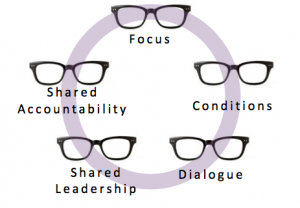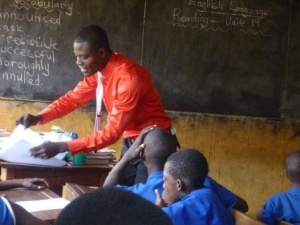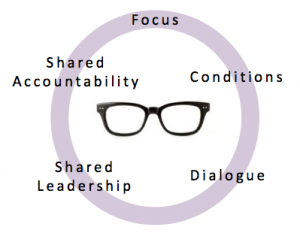Introduction to OER4Schools
1. Review of homework
2. Leadership for Learning - Introduction
![]() Reading (11 min). Read the following text.
Reading (11 min). Read the following text.
Leadership for Learning is a way of thinking, doing, communicating, working, and reflecting about educational leadership in schools for the singular purpose of promoting the activity of learning.
Five principles of Leadership for Learning are as follows:
- Focus on learning
- Conditions for learning
- Learning Dialogue
- Shared Leadership
- Shared Accountability
In this unit you will explore the five LfL principles in practice with a view to contributing your own ideas about Leadership for Learning through interactive learning opportunities.
This unit adopts the principles of LfL within its curriculum and pedagogy: creating the conditions for learning at a pace, time, and level of interaction of your own choosing.
You will have opportunities for discussing and sharing ideas about your learning and the learning experience.
LfL is not something that can be implemented or done-to a school or imposed on a person. LfL provides a framework that creates an opportunity for change; for expanding leadership capacity in schools and improving the quality of learning.
3. What is LfL? Introduction to LfL: It's all around
Leadership for learning is happening all around you.
If you know what to look for you will see elements of LfL in classrooms and schools, in your own community, and even in the setting in which you might be doing this unit!
You may be wondering, “If Leadership for Learning is all around me already, why am I doing this unit?” Well … the short answer is that even though the LfL principles are common attributes of many classrooms and whole schools, they are not present, coordinated or sustained at levels that support consistently positive learning effects.
The aims of this session (5.1) are to:
- Explore a metaphor for describing how we can start to ‘see’ Leadership for Learning in classrooms and schools
- Identify and explore the 5 LfL principles
- Watch a teacher in action, and see if some or all of the 5 LfL principles can be identified.
4. Practical: Seeing is believing
 Let’s start by considering a few ideas about LfL, its 5 principles, and how we might observe and identify these in classrooms and schools.
Let’s start by considering a few ideas about LfL, its 5 principles, and how we might observe and identify these in classrooms and schools.
We like to think about ‘seeing’ the LfL principles by using what we have come to call an ‘LfL Lens’ or set of ‘LfL Lenses’. What do we mean by lens? Figure 5A depicts a familiar image of spectacles or glasses that we can use to depict or stand in as a metaphor for what we mean by an LfL Lens.
![]() Stimulus (11 min). What do you think we mean by an LfL lens as illustrated in Figure 5A?
Stimulus (11 min). What do you think we mean by an LfL lens as illustrated in Figure 5A?
Pedagogy: Think, Pair, Share
THINK: Suggest each person works independently for 1 minute and identifies/thinks of 1 -3 responses/contributions. Participants make a note of each (mentally, or preferably, written down to support recall and reference).
PAIR: In pairs, participants discuss and compare ideas.
SHARE: The whole group comes together, with each pair contributing one or two ideas from their discussion.
Sample responses: “It helps you see things differently”, “An LfL lens makes you focus on LfL”, “It’s a way of describing how we look at the world differently depending on our attention or interests.”
5. Practical: The five lenses
 Let’s take our metaphor of the LfL lens a step further, and suggest that there are 5 different LfL lenses (spectacles) needed in order to ‘see’ all 5 LfL principles:
Let’s take our metaphor of the LfL lens a step further, and suggest that there are 5 different LfL lenses (spectacles) needed in order to ‘see’ all 5 LfL principles:
- Focus on learning
- Conditions for learning
- Learning Dialogue
- Shared Leadership
- Shared Accountability
Consider Figure 5B.
- What are the kinds of things you might see in a classroom if you were looking through the LfL lens ‘Focus on Learning’?
- What are the kinds of things you might see in a classroom if you were looking through the LfL lens ‘Conditions for Learning’?
- What are the kinds of things you might see in a classroom if you were looking through the LfL lens ‘Learning Dialogue’?
- What are the kinds of things you might see in a classroom if you were looking through the LfL lens ‘Shared Leadership?
- What are the kinds of things you might see in a classroom if you were looking through the LfL lens ‘Shared Accountability’?
Pedagogy: Jigsaw (or small group plenary) - creating and sharing 'expert' knowledge.
Extending the lens metaphor from the previous exercise, create five groups each focusing on one LfL principle to discuss “what are the kinds of things you might see…”. Either jigsaw, creating new groups with 'expert' envoys from each of five LfL principle groups, Or representatives from each group share with everyone in plenary. Identify natural overlaps and links across the 5 LfL principles and re-direct new questions back to the group for elaboration. This is a purely exploratory exercise, with no incorrect answers.
Consider Figure 5C
- What do you think might be the benefits of combining all LfL lenses into one?
- What do you think could be the drawbacks of looking at classrooms and schools with a single, combined lens?
Pedagogy: Debate preceded by snowballing and prioritisation.
SNOWBALL AND PRIORITISATION: Firstly create two groups, one considering the ‘benefits’ and the other the ‘drawbacks’ of looking at practice through a single combined lens.
In each group the process proceeds in stages: people first work independently, then in pairs, then two pairs join to create a four, then two fours join to create an eight and so on, until each of the two groups has ‘snowballed’ together.
At each stage, the task is: (a) to think about the benefits or drawbacks (depending which half of the whole group) of looking at practice through a single combined lens, and (b) to prioritise them into the top five items. Prioritisation should be achieved through dialogue to reach consensus. Once the snowball has brought together everyone considering each of the aspects (benefits / drawbacks), only three items should be prioritised.
DEBATE: Each half-group considers their agreed top three items and draws together the arguments for each point in preparation for the debate. Moderate a turn-by-turn debate about the benefits and drawbacks of observing/reviewing classrooms and schools through a single, combined lens.
Sample responses: Participants will understand that there are benefits of focussing on one thing (one LfL principle) at a time: “Focusing on one of the 5 LfL principles really helps to identify the specifics of practice”. Participants will also acknowledge that people, classrooms, and schools are complex, and begin to recognise that that the LfL principles don’t naturally occur in isolation of the others. A global view is also an essential component of observing the effects of practices in action.
6. Application of LfL lenses to a classroom situation
Let’s try putting this idea of looking at classroom teaching and learning through an LfL lens into practice.
We are going to watch a short teaching/classroom video.
Before we do, choose only 1 LfL lens that you will use as your ‘critical lens’ to ‘see’ the practices in this classroom. By choosing your 1 LfL lens, you should only ‘see’ and note down those things that your lens helps you to focus on.
For example, if you choose, ‘Conditions for Learning’, then try looking only for those things that you believe contribute to promoting conditions for learning in the video.
OK, watch the video now, wearing your chosen LfL spectacles!
Watch the video.
VIDEO
Is a bat a bird?
Is a bat a bird?
[[]], Template:Fullurl:, Duration: 4:18
Need an educator note here with some explanantion.
E.g. what are the elements of shared leadership?
![]() Whole group discussion (11 min).
Whole group discussion (11 min).
- Was there a supportive environment for pupil participation and dialogue in this lesson? If so, how did the teacher achieve this?
- How did she help pupils to work out whether the bat was a mammal? Did this discussion move their thinking forward?
- What did you think about teacher control and pupil learning in this video clip?
- How would you manage something similar in your classroom? How would you encourage pupil talk without losing too much control?
Pedagogy: ‘Table mats’ to record observation and reflection (2s or 3s)
Invite participants to work in 2s or 3s, and prepare a ‘table mat’ for recording. Each group has a large piece of paper, in the middle of which they draw a quadrant (if pairs) or a triangle (if 3s) big enough to record the outcomes of the group discussion. Divide the outside area of the paper into half or third (to match the group size).
Agree which LfL principle each group will adopt as their critical lens for watching the video.
As they watch the video, participants make notes in their outside area of the table mat.
After watching, participants share their observations and reflections, and together agree the salient points of the lesson from the perspective of their chosen LfL principle to record in the central area of the table mat.
Emphasise that there are no wrong answers, and groups should try their best to focus their attention using their chosen LfL lens.
Extension: The table mats could be collected and displayed for whole group, firstly comparing any that focused on the same LfL principle, then comparing those that used differing lenses. Exploration of the similarities and differences is likely to reinforce the understanding that using a single lens brings specific aspects of a lesson into sharper focus, and that the five principles are interrelated and overlap.
7. LfL across your course
- Practical work: Refer to previous sessions/materials.
- How will it be recorded?
- Need to be precise about what they will do.
8. Reflecting and Sharing your Learning
You now understand that LfL is all about learning. It is about seeing the component parts that contribute to creating learning and leadership opportunities in classrooms, schools and communities.
By seeing things differently, through the 5 LfL lenses (or all at once with a combined lens when you are ready to give it try) we are better able to understand what it is we do as practitioners in support of the activity of learning.
It is through knowledge and insights of the leadership for learning principles that we are able to reflect upon and share our experiences and understandings with our colleagues.
Practice using the LfL lenses when you are back in your own schools, or even when you are watching others in the act of teaching and learning.
9. HOMEWORK
peer obs based on afl
10. Acknowledgement
This page was authored by Stephen Jull, drawing on collaborative work with Sue Swaffield and John MacBeath of the Centre for Commonwealth Education, University of Cambridge.



